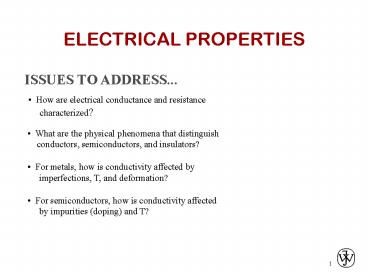ELECTRICAL PROPERTIES - PowerPoint PPT Presentation
1 / 15
Title:
ELECTRICAL PROPERTIES
Description:
... (1932); and C.A. Wert and R.M. Thomson, Physics of Solids, 2nd ed., McGraw-Hill Book Company ... imperfection sites lower the activation energy to ... – PowerPoint PPT presentation
Number of Views:116
Avg rating:3.0/5.0
Title: ELECTRICAL PROPERTIES
1
ELECTRICAL PROPERTIES
ISSUES TO ADDRESS...
How are electrical conductance and resistance
characterized?
What are the physical phenomena that
distinguish conductors, semiconductors, and
insulators?
For metals, how is conductivity affected by
imperfections, T, and deformation?
For semiconductors, how is conductivity
affected by impurities (doping) and T?
1
2
VIEW OF AN INTEGRATED CIRCUIT
Scanning electron microscope images of an IC
(a)
(d)
A dot map showing location of Si (a
semiconductor) --Si shows up as light
regions.
(b)
A dot map showing location of Al (a
conductor) --Al shows up as light regions.
(c)
Fig. (d) from Fig. 18.25, Callister 6e. (Fig.
18.25 is courtesy Nick Gonzales, National
Semiconductor Corp., West Jordan, UT.)
Fig. (a), (b), (c) from Fig. 18.0, Callister 6e.
2
3
ELECTRICAL CONDUCTION
Ohm's Law
DV I R
voltage drop (volts)
resistance (Ohms)
current (amps)
Resistivity, r and Conductivity, s
--geometry-independent forms of Ohm's Law
E electric field intensity
resistivity (Ohm-m)
J current density
conductivity
Resistance
3
4
CONDUCTIVITY COMPARISON
-1
Room T values (Ohm-m)
Selected values from Tables 18.1, 18.2, and 18.3,
Callister 6e.
4
5
EX CONDUCTIVITY PROBLEM
Problem 12.2, p. 524, Callister 2e
What is the minimum diameter (D) of the wire so
that DV lt 1.5V?
100m
lt 1.5V
2.5A
7
-1
6.07 x 10 (Ohm-m)
Solve to get D gt 1.88 mm
5
6
CONDUCTION ELECTRON TRANSPORT
Metals -- Thermal energy puts many
electrons into a higher energy state.
Energy States -- the cases below for
metals show that nearby energy states
are accessible by thermal fluctuations.
6
7
ENERGY STATES INSULATORS AND SEMICONDUCTORS
Insulators --Higher energy states not
accessible due to gap.
Semiconductors --Higher energy states
separated by a smaller gap.
7
8
METALS RESISTIVITY VS T, IMPURITIES
Imperfections increase resistivity --grain
boundaries --dislocations --impurity
atoms --vacancies
These act to scatter electrons so that they take
a less direct path.
Resistivity increases with
--temperature --wt impurity --CW
Adapted from Fig. 18.8, Callister 6e. (Fig. 18.8
adapted from J.O. Linde, Ann. Physik 5, p. 219
(1932) and C.A. Wert and R.M. Thomson, Physics
of Solids, 2nd ed., McGraw-Hill Book Company, New
York, 1970.)
8
9
EX ESTIMATING CONDUCTIVITY
Question
--Estimate the electrical conductivity of a Cu-Ni
alloy that has a yield strength of 125MPa.
Adapted from Fig. 18.9, Callister 6e.
Adapted from Fig. 7.14(b), Callister 6e.
9
10
PURE SEMICONDUCTORS CONDUCTIVITY VS T
Data for Pure Silicon --s increases with
T --opposite to metals
electrons can cross gap at higher T
material Si Ge GaP CdS
band gap (eV) 1.11 0.67 2.25 2.40
Adapted from Fig. 19.15, Callister 5e. (Fig.
19.15 adapted from G.L. Pearson and J. Bardeen,
Phys. Rev. 75, p. 865, 1949.)
10
Selected values from Table 18.2, Callister 6e.
11
CONDUCTION IN TERMS OF ELECTRON AND HOLE MIGRATION
Concept of electrons and holes
Adapted from Fig. 18.10, Callister 6e.
Electrical Conductivity given by
3
holes/m
hole mobility
3
electron mobility
electrons/m
11
12
INTRINSIC VS EXTRINSIC CONDUCTION
Intrinsic electrons holes (n p)
--case for pure Si
Extrinsic --n ? p --occurs when
impurities are added with a different
valence electrons than the host (e.g., Si atoms)
N-type Extrinsic (n gtgt p)
P-type Extrinsic (p gtgt n)
12
13
DOPED SEMICON CONDUCTIVITY VS T
Data for Doped Silicon --s increases
doping --reason imperfection sites
lower the activation energy to produce
mobile electrons.
Comparison intrinsic vs extrinsic
conduction... --extrinsic doping level
1021/m3 of a n-type donor impurity (such
as P). --for T lt 100K "freeze-out"
thermal energy insufficient to excite
electrons. --for 150K lt T lt 450K
"extrinsic" --for T gtgt 450K "intrinsic"
Adapted from Fig. 18.16, Callister 6e. (Fig.
18.16 from S.M. Sze, Semiconductor Devices,
Physics, and Technology, Bell Telephone
Laboratories, Inc., 1985.)
Adapted from Fig. 19.15, Callister 5e. (Fig.
19.15 adapted from G.L. Pearson and J. Bardeen,
Phys. Rev. 75, p. 865, 1949.)
13
14
P-N RECTIFYING JUNCTION
Allows flow of electrons in one direction only
(e.g., useful to convert alternating current
to direct current. Processing diffuse P into
one side of a B-doped crystal. Results
--No applied potential no net current flow.
--Forward bias carrier flow through p-type
and n-type regions holes and electrons
recombine at p-n junction current flows.
--Reverse bias carrier flow away from p-n
junction carrier conc. greatly reduced at
junction little current flow.
14
15
SUMMARY
Electrical conductivity and resistivity are
--material parameters. --geometry
independent. Electrical resistance is --a
geometry and material dependent parameter.
Conductors, semiconductors, and insulators...
--different in whether there are accessible
energy states for conductance electrons.
For metals, conductivity is increased by
--reducing deformation --reducing
imperfections --decreasing temperature.
For pure semiconductors, conductivity is
increased by --increasing temperature
--doping (e.g., adding B to Si (p-type) or P to
Si (n-type).
15

